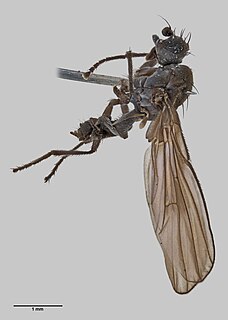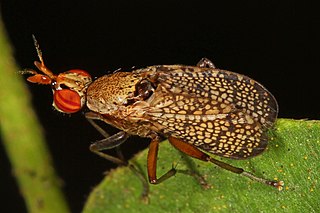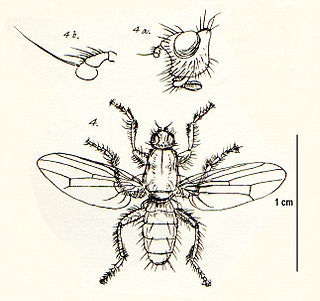
The family Sciomyzidae belongs to the typical flies (Brachycera) of the order Diptera. They are commonly called marsh flies, and in some cases snail-killing flies due to the food of their larvae.

The Chamaemyiidae are a small family of acalyptrate flies with less than 200 species described worldwide. The larvae of these small flies are active and predatory and are often used for biological control of aphids, scale insects, and similar pests. Chamaemyiid fossils are poorly represented in amber deposits, but a few examples are known from the Eocene epoch onwards.

The Coelopidae or kelp flies are a family of Acalyptratae flies, they are sometimes also called seaweed flies, though both terms are used for a number of seashore Diptera. Fewer than 40 species occur worldwide. The family is found in temperate areas, with species occurring in the southern Afrotropical, Holarctic, and Australasian regions.

The Pyrgotidae are an unusual family of flies (Diptera), one of only two families of Cyclorrhapha that lack ocelli. Most species are "picture-winged", as is typical among the Tephritoidea, but unlike other tephritoids, they are endoparasitoids; the females pursue scarab beetles in flight, laying an egg on the beetle's back under the elytra where the beetle cannot reach it. The egg hatches and the fly larva enters the body cavity of the beetle, feeding and eventually killing the host before pupating. In the United States, some species of Pyrgota and Sphecomyiella can be quite common in areas where their host beetles are abundant. Like their host beetles, these flies are primarily nocturnal, and are often attracted to artificial lights.

Ceromya is a genus of tachinid flies in the family Tachinidae, containing the following species:

Trupanea is a genus of tephritid or fruit flies in the family Tephritidae.

Actia is a genus of large flies in the family Tachinidae.

The Helcomyzidae are a small family of flies in the Acalyptratae. The larvae feed on kelp and other organic matter washed up on shorelines. Species diversity is highest in New Zealand and south temperate South America. They are sometimes allied with the families Dryomyzidae or Coelopidae.

Apetaenus is a genus of beach flies in the family Canacidae. They are endemic to the subantarctic archipelagos in association with colonies of penguins and other seabirds. Some species have vestigial wings.

Tetanocerini is a tribe of flies in the family Sciomyzidae. There are at least 120 described species in the tribe.

Coelopa is a genus of kelp flies in the family Coelopidae. There are about 14 described species in Coelopa.

Sciomyzinae is a subfamily of flies in the family Sciomyzidae.
Coelopina is a genus of kelp flies in the family Coelopidae.

Chaetocoelopa is a genus of kelp flies in the family Coelopidae.
Beaopterus is a genus of kelp fly in the family Coelopidae.
Coelopella is a genus of kelp flies in the family Coelopidae.
Glumini is a tribe of kelp flies in the family Coelopidae.
Coelopellini is a tribe of kelp flies in the family Coelopidae.
Coelopini is a tribe of kelp flies in the family Coelopidae.
Coelopinae is a subfamily of kelp flies in the family Coelopidae.












